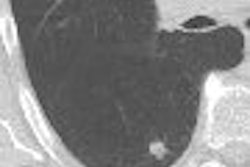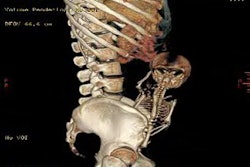Multislice cardiac CT angiography (CTA) offers a fast, comprehensive, one-stop look at the heart that could potentially replace invasive coronary angiography for many applications.
But there are, of course, patients who shouldn't be scanned, and as gatekeepers, radiologists and cardiologists are duty bound to find and exclude them, according to a presentation at Stanford University's International Symposium on Multidetector-Row CT in San Francisco.
Patients with severe contraindications, as well as those who can be safely scanned but whose images would likely be nondiagnostic, can generally be examined with traditional angiography.
The benefits of cardiac CTA are potentially "revolutionary," said Dr. Guy Weigold, a cardiology faculty member and director of cardiac CT at the Washington Hospital Center in Washington, DC. But it's important to remember that CTA is tricky scan, a "one-shot acquisition with a relatively thin margin of error and limited forgiveness," he said. "Patient selection and preparation clearly are key to obtaining diagnostic images on a consistent basis."
And for primary care physicians who have primary responsibility for selecting patients, "as imagers, whether you're a cardiologist or a radiologist, we have a role in preventing harm to the patient" by excluding those with contraindications or weak indications, and patients for whom the risk of harm outweighs the benefits of the scan, Weigold said.
To scan or not to scan -- it's not always an easy call. The only absolute contraindication is the uncooperative patient, "who cannot comply with the simple instruction to hold their breath and sit still," he said. Other contraindications are relative, and include, for example, patients with contrast allergies, renal insufficiency, and very young or adolescent patients.
In young people, "we're dealing with scans that are higher dose of radiation than normal and I think this needs to be taken into consideration," Weigold said.
Also, patients with severe valvular or obstructive airway disease should generally not undergo CTA, he said. Atrial fibrillation and severe ectopy are two additional contraindications that can kill image quality, but both of these settings have potential in emerging software applications, Weigold said.
Scanning patients with atrial fibrillation is an area of research that may someday produce consistently good CT images, but for now it must be considered a relative contraindication, he said.
"Ectopic beats result in the distortion of images," but contraindications to CTA are relative because "there are ways to correct this with software applications and algorithms," Weigold said. The ECG can be edited by deleting beats that cause problems, for example, restoring image quality.
Contraindications to beta-blockers can be another CTA deal breaker. Despite some interesting preliminary research with dual-source CT, Weigold said, most scanners generally still require heart rates of 60 bpm or less to produce good image quality, and to achieve that rate, IV or oral beta-blockade (generally with metropolol) is required.
Contraindications related to beta-blockers include unexplained tachycardia, decompensated heart failure, severe valvular disease, unprotected heart block, and severe obstructive airway disease.
There are also patients with contraindications to nitroglycerine, which enlarges the vessels and makes them easier to visualize on CT. Nitroglycerine is not essential, but it's "good to have on board," Weigold said. But patients who have recently been treated for erectile dysfunction should definitely not be given nitroglycerine.
Implanted devices represent a more variable source of imaging problems. There are still, for example, patients with simple dual-chamber pacemakers that don't produce much artifact on CT, but "ICDs (intracoronary devices) may produce a bit more artifact, and some obscure the right coronary artery," he said. "Biventricular devices produce a fair amount of metal artifact, and may obscure a good portion of the coronary tree and prevent adequate visualization."
Obesity is a very relative contraindication, and success depends a great deal on its severity. In patients with a body mass index of 40-50, for example, it is definitely easier to image those at the lower end of the scale.
Even for the larger patients, "it is possible with optimal heart rate reduction and the use of dose modulation to obtain adequate image quality by using higher tube current," Weigold said, "but let's not forget the price of a higher dose of radiation. At 17, 21, 25 mSv, we're getting into a range of radiation in which (CTA) is no longer really comparable to plain old invasive coronary angiography. Generally, when you start tipping the scales at a BMI of 40, there are certain situations, I would say, where cardiac CT is pretty much contraindicated."
It certainly can be a waste of scan time and radiation dose when the heart and vessels are poorly visualized and the scan is nondiagnostic. When deciding whether to scan morbidly obese patients, Weigold listed the following co-factors under the "no" category:
- High heart rate
- Irregular rhythm
- Weak indication
- CABG/stent
- Under age 60
- Women
- BMI greater than 45
"In these cases we still have good, old-fashioned invasive coronary angiography that will answer the (diagnostic) question for us and provide a therapeutic modality as well," he said. "On the other hand there are some situations in which it may be acceptable to use cardiac CT when catheterization is really undesirable."
These co-factors in morbidly obese patients nudged CTA into the "maybe" category:
- Catheterization undesirable
- Heart rate less than 65 bpm
- Regular sinus rhythm
- Good IV access
- Normal renal function
- Age greater than 70 (due to lower radiation sensitivity)
- BMI closer to 40
Critical patient prep
Patients should arrive for imaging having avoided solid food for three hours. They should also be free of caffeine, erectile dysfunction drugs, and the antidiabetic drug metformin, though other medications should be taken normally. Liquids should definitely not be avoided; patients need to drink water to avoid becoming dehydrated or volume-depleted, Weigold advised.
When patients arrive at the facility 30 minutes before scan time, a nurse hooks up the ECG monitor, observes heart rate and rhythm, takes blood pressure, and begins administering IV beta-blockers (up to 30 mg, 5 mg at a time) until the heart rate is under 60 bpm, assuming it is faster than that when they arrive. If the IV blockade is ineffective, oral metropolol (50-100 mg) usually does the trick, Weigold said.
Doctors should bear in mind that heart rates tend to be about 10 bpm higher in the scanner than in the exam room.
"I don't know why that is, but just something about lying on a table with a gantry spinning around you in a cold room with the lights on, I guess, raises heart rate and the anxiety level," he said. "So modulate the heart rate, at least for the time being, until new technology leads us in a different direction."
Practice the breath-hold with patients beforehand so patients will know exactly how to do it and how long they'll have to hold it. A small amount of respiratory motion will render the scan nondiagnostic, so talk to the patient about the importance of the breath-hold and of remaining motionless, Wiegold said. If there's a question about the presence of breathing artifact, verify by looking at the lung fields and rescan if necessary, he said.
The last step after the scout scan and before CTA is the administration of nitroglycerine in sublingual tablets or spray form (800 μg).
"Remember that attentive and careful patient prep is a crucial requirement for consistently achieving high-quality cardiac CT scans," Weigold said. "If you do that carefully and pay attention ... I think you'll be happy with results."
By Eric Barnes
AuntMinnie.com staff writer
July 17, 2006
Related Reading
Less radiation dose exposure in cardiac CT is possible. July 6, 2006
Dual-source imaging promises better CT scanning, June 15, 2006
CT angiography detects significant coronary lesions prior to valve surgery, June 8, 2006
Concentrated iodine permits lower volumes in cardiac CTA, May 22, 2006
Cardiac imaging dazzles, but radiologists can't compete alone, April 10, 2006
Copyright © 2006 AuntMinnie.com



















